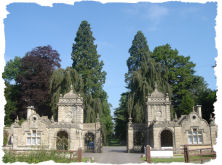
About the Arboretums Project
![]() he concept of arboretums as spaces for the growth, display and study of trees and shrubs was developed in Britain during the eighteenth and early nineteenth centuries and they provided an important model for the development of public and private parks and gardens. Arboretums became popular in the period largely in response to changes in culture and society, developments in landscape gardening, aesthetics, Enlightenment science, global trade and exploration.
he concept of arboretums as spaces for the growth, display and study of trees and shrubs was developed in Britain during the eighteenth and early nineteenth centuries and they provided an important model for the development of public and private parks and gardens. Arboretums became popular in the period largely in response to changes in culture and society, developments in landscape gardening, aesthetics, Enlightenment science, global trade and exploration.
They also played an important role in the development of the first provincial public parks. George Sinclair declared in 1832 that ‘the interest arising from the adoption of foreign trees into domestic scenery’ is ‘not confined to their picturesque effects.’ It reminds all ‘of the climes whence they come, of the scenes with which they were associated’ so that ‘in exploring a well selected arboretum, the eternal snows of the Himalaya, the savannahs of the Missouri, the untrodden forests of Patagonia, the valleys of Lebanon, pass in review before us; we seem to wander in other climes, to converse with other nations.’
The Study
This study is the first general cultural history of the arboretum in Britain and utilises case studies of different types of arboretums, public, semi-public and private, to reveal their scientific, cultural and social significance. It examines the changing practical, aesthetic, philosophical, educational and scientific principles underpinning the design and management of arboretums. It also explores the management and consumption of tree collections, particularly the tension between naturalistic and geometric aesthetics and biological taxonomies.
It builds directly upon Stephen Daniels’ work in cultural and historical geography, the history of landscape gardening and the arboreal image in art and literature, Paul Elliott’s work on British scientific culture, the history of science and the Derby Arboretum, Daniels and Elliott’s work on geographical education and identity and upon Charles Watkins’ studies of the cultural history and management of trees, to create a comprehensive and authoritative study of British arboretums in their scientific, social and cultural context.
The Results
The results are being published in a series of journal articles, a monograph and an edited collection. There is also a major international conference on the cultural geography of arboretums at the Linnean Society, London, 6-8 September, 2006.The rest of this site shows examples of some of the different kinds of arboretum that flourished in nineteenth century Britain, reveals some of the sources that are being exploited in their analysis and provides details of the international conference.
